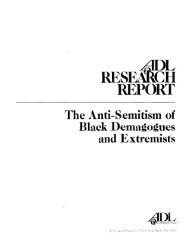Create successful ePaper yourself
Turn your PDF publications into a flip-book with our unique Google optimized e-Paper software.
Document Results<br />
o<br />
o<br />
Page 2 of8<br />
thought to have some fourteen other facilities, including heavy- and light-water reactors in Isfahan and<br />
Arak, and suspect sites In Fasa, Karaj, "and Nekka. Together, these constitute all the makings of an<br />
ambitious national effort to develop nuclear weapons. (3) Iranian officials, meanwhile, have hinted at the<br />
existence of still other, as yet u-ndisclosed, facilities essential to the country's nuclear program. (4)<br />
Iran appears to have agreed to suspend its uranium enrichment activities under an October 2003 deal<br />
with France, Germany, and Great Britain. Similarly, international pressure succeeded In prompting Iran<br />
to sign the Additional Protocol to the 1968 Nuclear Nonproliferation Treaty (NPT), permitting snap<br />
inspections and invasive monitoring of segments of Iran's nuclear sector by the International Atomic<br />
Energy Agency. However, two of Iran's main atomic suppliers,' Russia and China, wield veto power on<br />
the United Nations Security Council, making it improbable that Iranian nuclear violations would result In<br />
meaningful censure. And in fact, ongoing IAEA deliberations have so far failed to yield decisive<br />
international action, despite mounting evidence of Iran's atomic breaches.<br />
There is also a lingering uncertainty over Tehran's nuclear time line. While informed American observers<br />
contend that Iran is still some two years (and possibly longer) away from an offensive nuclear capability,<br />
(5) others believe that an Iranian bomb could materialize much sooner. In November 2003 testimonybefore<br />
the Israeli parliament's Foreign Affairs and Defense Committee, Mossad chief Meir Dagan warned<br />
that Iran could reach a "point of no return" in its nuclear development by mid-2004, following which time<br />
an Iranian offensive capability would become a virtual certainty. (6) President Bush has himself warned<br />
that the United States "will not tolerate" a nuclear-armed Iran. (7) But if estimates are off, even by a<br />
few months, Iran could present the world with a nuclear fait accompli.<br />
At the same time, major breakthroughs in Iran's strategic arsenal have made it an emerging missile<br />
power. In June 2003, the Islamic Republic conducted what it termed the final test of its 1,300"<br />
kilometer range Shahab-3 ballistic missile. The launch was a success, confirming Iran's ability to target<br />
U.S. allies Israel and Turkey, as wen as U.S. troops in the Persian Gulf. Since then, with great fanfare,<br />
the Islamic Republic has inducted the advanced rocket Into its Revolutionary Guards (the Pasdaran). (8)<br />
This potential for proliferation is hardly the only worry. If recent signals are any indication, the Shahab<br />
3 has already evolved well beyond its.officially declared capabilities. In September 2003, at a military<br />
parade commemorating the anniversary of the 1980-88 Iran-Iraq war, the Shahab-3 was officially<br />
described as possessing a range of 1,700 kilometers. (9) Additionally, opposition groups have charged<br />
that Tehran's overt missile development actually masks a much broader clandestine endeavor-.-one that<br />
includes development of the 4,OOO-kllometer range Shahab-5 and even a follow-on Shahab-6<br />
Intercontinental ballistic missile. (10)<br />
Such efforts have only been strengthened by Iranian perceptions of U.S. policy. The Bush<br />
administration's rapid dispatch of Saddam Hussein's regime, and its contrasting hesitancy in dealing with<br />
a newly nuclear North Korea, has had a profound impact on Iran's calculus. North Korea's nuclear<br />
maneuvers, and its ability to successfully stymie U.S. strategy, have led Iranian officials to express their<br />
admiration for Pyongyang's resistance to U.S. "pressure, hegemony and superiority.II (11) There has<br />
indeed been some internal debate in Iran about the risks of stepping over the nuclear threshold. Yet<br />
even leading Iranian reformers appear to have gravitated to the notion that nuclear weapons are<br />
necessary to shift the regional "equilibrium." (12)<br />
CHARM OFFENSIVE<br />
These strategic advances, however, are only part of the picture. In tandem with Iran's nuclear and<br />
ballistic missile breakthroughs, a significant transformation has also begun in Iranian foreign policy.<br />
For Tehran, the overthrow of Hussein's regime has only fueled mounting fears of a danger0t!s str~tegic<br />
encirclement. The U.S. destruction ofthe Taliban regime in Afghanistan had already ensconced the pro<br />
Western--albeit fragile--government of Hamid Karzai In Kabul. For Iran, the extremist Sunni Taliban<br />
posed an ideological threat, but a U.S. foothold on Iran's eastern border is regarded as even more<br />
threatening. Regime change In Baghdad, therefore, confronted officials in Tehran with the two-fold<br />
danger that Iran could be pinioned between two U.S.. client-states, and that Iraq's fall might be a prelude<br />
-to a similar U.S. drive to transform their country.<br />
In response, Iran formulated its new strategic doctrine of "deterrent defense." In practice, this has<br />
entailed a major expansion of Iran's military capabilities. Heavy defense expenditures, and ongoing<br />
strategic partnerships with both Russia and China, have made possible a far-reaching national military<br />
https:/Iw3.1~xis.comllawenfsolutions_secured/searchfonns/doBrowse.asp?SearchInfoID=...11118/2004




